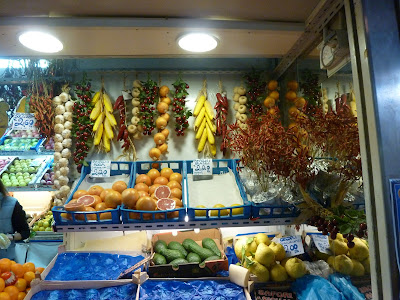I started out my morning at Trionfale
with Nina and Teresa:
 |
| politics.... this is not a joke |
… and of course stopped off at our
delicious pastry shop
We spendt the rest of the afternoon and
evening exploring the neighborhood of Garbatella. It is oficially my
favorite neighborhood in Rome... and possibly ever. It has a
facinating history which still impacts life there today. Check this out... I promise it is worth your time:
Walking Questioning
By Gianluca Peciola
An October
morning in 1994 I discovered the intimacy of Garbatella, as well as the warmth
of its lotti.[1] Prior, passing through the streets of the
neighborhood, I had only skimmed its surface. That day I found myself with my
friends and my fellow political adventurers, giving a new self-governed space
to the city, what would later become the Centro Sociale La Strada. We were many that day, young people and
dreamers, seized by the concrete utopia of the recent Zapatista
revolution. I remember the light of that
morning, the activity of the small, noisy neighborhood as it awoke, the
expressions of its people, their curiosity towards those who would later open
La Strada as a social, cultural and political space open to all. I remember the trip from the Lotto to the
door of the Center like a partisan walk.[2] Like an Indian line we walked towards a new
adventure, the still dim sun failed to warm our steps, the women who had just
left their houses looked at us with curiosity, sympathy and secret
connivance. The community was familiar
with our clandestine attitudes, that unique disposition of someone who is about
to break the law in order to affirm a principle. Garbatella is the neighborhood of a people
who do not lower their heads but prefer to have them cut off. The intentions of fascism—to make Garbatella
an ‘organic’ community and to create, through the forceful implementation of
rules, a collective society adherent to its “values”—were quickly frustrated.[3] From the Albergho Rosso[4] to
the last Lotto, fascism had to deal with a humanity not at all inclined to
swallow the dictatorship. Garbatella was
a workshop of the Resistance: many were supporters of the Communist Party and
the other forces of the CLN.[5] Even the building that is now the “city of
children” kindergarten was occupied immediately after the liberation of the
“Bandiera Rossa”, one of the most aggressive antifascist political
organizations. The idea was to make it a
center of socialization and political liveliness for the neighborhood. Fascism had thought of naming the
neighborhood “Concordia”, a clumsy attempt at peace making.[6] But local tradition prevailed, and with it
the name Garbatella.
Garbatella is a neighborhood of
incredible beauty. Built during 1920 and
1929, it was part of a plan by the Istituto Case Popolari (Institute of Public
Housing) whose objective was “to accommodate the workers of the industrial zone
within that same area”. Subsequently it
began to house many of those who had paid for the policy of the “sventramenti”[7]
(literally, “gutting” or “demolition”) of the Historic Center and the
demolition of the shanties present on the consular roads, the Aurelian Wall and
the Porta Metronia.[8] The initial project of this “garden city” was
influenced by the ideas of the Fabian Society and from the Utopian Socialists
Robert Owen and William Morris. At
bottom the idea is that of an urban planning which allows one to experience
ideal cohabitation in a small community, in which aspects of family life and
the development of the individual can find a harmonious balance in an
economically self-sufficient space, with all services available, from social
ones to those linked to the distribution and consumption of goods. A place in which countryside and city,
industry and agriculture find a perfect synthesis. But the construction of the neighborhood soon
came up against the contradictions and the omnipotent vision of Fascism. It was in Garbatella that the regime fell for
the social costs of the “sventramenti”, it was here the ‘organic’ idea that the Duce (Mussolini) wanted to cast on the
neighborhood changed, transforming itself into the nightmare of a community
hostile to the dictatorship.
In this
guide you will not find the cold representation of a neighborhood presented to
the world for its aesthetic beauty; or better, you won’t find only this. Here a community is described, first of all,
for the real wealth that it gives to the city and to the country; a more
cohesive humanity, despite the anxiety of political speculation and its
continued aggressions against the neighborhood’s nature and its will to
maintain the roots of its identity. A
community that tries to maintain the memory of the place, of an area in which
the memory of the massacre of the Fosse Adreatine[9]
and the figure Piero Bruno, Lotta Continua militant killed by police in 1975,
is strong; in which the original social mutualism finds new vigor in the
practices of an alive and energetic ‘associationism’; in which self-governed
places, such as the Centro Sociale “La Strada” and the “Casetta Rossa”, put
services in place and develop links with other communities in the most remote
places of the world that produce alternatives to the social and economic
dominance of the market.
When you visit
Garbatella, pay attention to the echoes and to the voices of its past, visit
with an open heart, linger with its inhabitants, make yourself hollow in order
to receive the soul of a people proud and valiant as their history.
[1] Garbatella is divided into Lotti, collections of houses arranged
around internal gardens that serve as informal meeting points for families and
play places for children.
[2] Partisans are those who
fought against the fascists and the Nazis during World War II.
[3] “Organic community” simply
means organized community; it is an example of the Fascists’ attempt to
manipulate society through language, in this case by replacing a common word
with a fascist euphemism.
[4] “The Red Hotel.” One of three hotels built by the fascists at
the end of the 1920s that represent the end of the development of the true
Garbatella vision.
[5] The National Liberation
Committee, an association of political parties united by their anti-fascism and
opposition to the German occupation.
[6] Concordia means “harmony”.
[7] “Sventramenti” refers to
the Fascist policy of destroying medieval Roman neighborhoods in order to build
wide roads and new buildings. A couple
good examples of this are the areas around St. Peter’s and the Colosseo.
[8] The Aurelian wall is the ancient
wall that surrounds the old city, and the Porta Metrona is one of its gates, in
the San Giovanni neighborhood.
[9] Fosse Adreatine was a mass
execution carried out by Nazi troops in Rome as a reprisal against a partisan
attack. We visit the site as part of our
World War II study trip.
Garbatella has a feeling
about it all its own which is why I strongly recommend visiting it
for yourself and not just as a tourist, but as a traveler.
 |
| Casa Rosa. My favorite hangout/restaurant/study spot/communist bar in Rome. |
 |
| Old, Gratified B-line trains. |


















